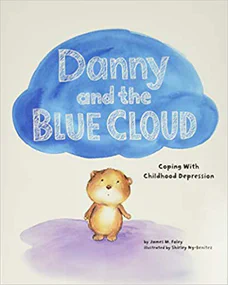Danny and the Blue Cloud
Coping with Childhood Depression
Written by James Foley, D.Ed.
Illustrated by Shirley Ng-Benitez
32 pages
•
Published 2016 (Magination Press)

Recommended Age Range: Best for young children–preschool through kindergarten, maybe first grade.
Publisher's Summary:
Danny was born under a blue cloud. He didn’t know why, but sometimes the cloud made him cry. Some days he didn’t want to get out of bed. Some days he was one big GROWL! With the help of Barnaby the rabbit, Danny learns to think more helpful thoughts, feel better about himself, and dance his way into a better mood! He practices Barnaby’s “Feel-Good Rules” until his cloud turns lighter and brighter.

Dr. Annie's Takeaways
Recommended for: Good for young children who are struggling with their mood (or as this books says, who are “born under a blue cloud”). This book could function well in therapy as an introduction to Cognitive-Behavioral Therapy (CBT)
and at home as an introduction to the benefits of positive self-talk and getting out of bed to do fun things even when we don’t feel like it!
Would a child like it? A young child who identifies with Danny will likely appreciate that they aren’t alone in their struggles. The book really pulls for the adult and child(ren) reading this book to get up and have a dance party afterwards, which likely will help the child reading this book feel a little better too!
Tone: Upbeat, a bit silly, hopeful
Story Quality: The story is a vessel for psychoeducation
, but as vessels for psychoeducation go, it’s a sweet story with some light humor as well as a relatively realistic portrayal of depression, which gives it a bit of depth and authenticity. It has a “happily ever after” ending, which I never think is totally honest, but the story is hope-inducing and makes a strong case for getting up and dancing even if you don’t feel like it.
Illustrations: Brightly-colored, watercolor illustrations of cute anthropomorphized woodland animals.
Representation: The characters are forest animals. Danny is a male bear, and Barnaby is a male rabbit. Danny lives with his mother. There is a pivotal moment when Danny realizes he’s a good dancer, and he teaches the rest of the forest animals to dance.
Psychological Practices: Includes a succinct description of depression symptoms–crying without knowing why, difficulty getting out of bed, moving slowly, irritability (“Some days, Danny was one big GROWL”). Barnaby the Rabbit cajoles Danny out of bed and gently challenges Danny’s negative self-talk (“If you have never climbed or played in the forest, how do you know that you are the worst climber and player in the forest?”). He then shares a list of “Feel Good Rules” with Danny: “Think about GOOD things instead of just focusing on BAD things. Think about what you CAN do and not what you CAN’T do. Dance even when you don’t want to dance. MOVING MAKES YOU FEEL BETTER. Think GOOD things about yourself even if it feels easier to think bad things.” This list is a little bit more black-and-white about “good things” and “bad things” than I’d prefer, but there’s some subtly–it acknowledges that he’ll still focus on bad things sometimes, but ideally not exclusively; it recognizes that it’s often easier to think bad things about oneself; one might not always want to dance. This book most effectively makes the case that it’s important to get up and move even if you don’t feel like it.
Concerns: The book ends with Danny’s blue cloud turning into a rainbow suggesting that his depression is cured (or at least fully gone in that moment). Most children with depression will need to revisit their coping strategies repeatedly, and it seems a bit dishonest to me to suggest that a handful of coping strategies will fully address a child’s depression symptoms.
